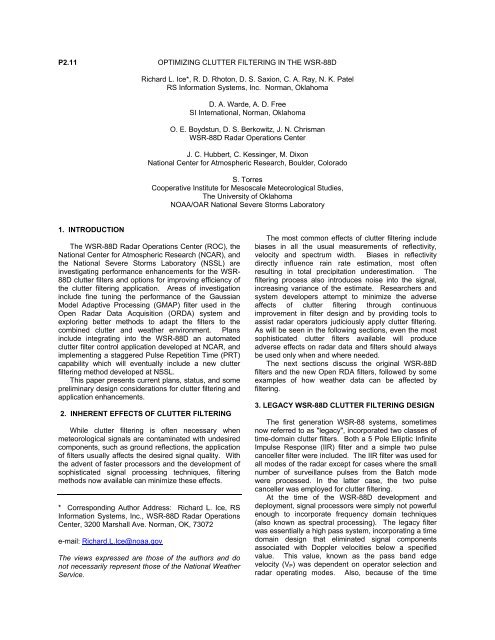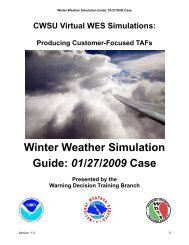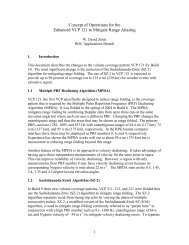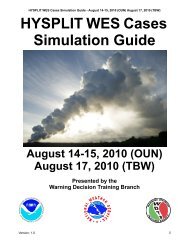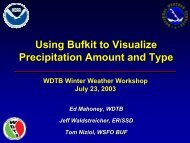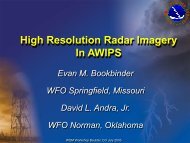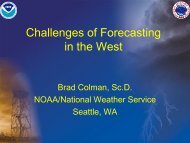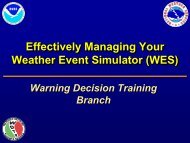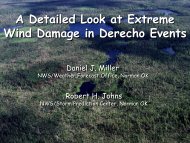P2.11 OPTIMIZING CLUTTER FILTERING IN THE WSR-88D ...
P2.11 OPTIMIZING CLUTTER FILTERING IN THE WSR-88D ...
P2.11 OPTIMIZING CLUTTER FILTERING IN THE WSR-88D ...
You also want an ePaper? Increase the reach of your titles
YUMPU automatically turns print PDFs into web optimized ePapers that Google loves.
<strong>P2.11</strong> <strong>OPTIMIZ<strong>IN</strong>G</strong> <strong>CLUTTER</strong> <strong>FILTER<strong>IN</strong>G</strong> <strong>IN</strong> <strong>THE</strong> <strong>WSR</strong>-<strong>88D</strong>Richard L. Ice*, R. D. Rhoton, D. S. Saxion, C. A. Ray, N. K. PatelRS Information Systems, Inc. Norman, OklahomaD. A. Warde, A. D. FreeSI International, Norman, OklahomaO. E. Boydstun, D. S. Berkowitz, J. N. Chrisman<strong>WSR</strong>-<strong>88D</strong> Radar Operations CenterJ. C. Hubbert, C. Kessinger, M. DixonNational Center for Atmospheric Research, Boulder, ColoradoS. TorresCooperative Institute for Mesoscale Meteorological Studies,The University of OklahomaNOAA/OAR National Severe Storms Laboratory1. <strong>IN</strong>TRODUCTIONThe <strong>WSR</strong>-<strong>88D</strong> Radar Operations Center (ROC), theNational Center for Atmospheric Research (NCAR), andthe National Severe Storms Laboratory (NSSL) areinvestigating performance enhancements for the <strong>WSR</strong>-<strong>88D</strong> clutter filters and options for improving efficiency ofthe clutter filtering application. Areas of investigationinclude fine tuning the performance of the GaussianModel Adaptive Processing (GMAP) filter used in theOpen Radar Data Acquisition (ORDA) system andexploring better methods to adapt the filters to thecombined clutter and weather environment. Plansinclude integrating into the <strong>WSR</strong>-<strong>88D</strong> an automatedclutter filter control application developed at NCAR, andimplementing a staggered Pulse Repetition Time (PRT)capability which will eventually include a new clutterfiltering method developed at NSSL.This paper presents current plans, status, and somepreliminary design considerations for clutter filtering andapplication enhancements.2. <strong>IN</strong>HERENT EFFECTS OF <strong>CLUTTER</strong> <strong>FILTER<strong>IN</strong>G</strong>While clutter filtering is often necessary whenmeteorological signals are contaminated with undesiredcomponents, such as ground reflections, the applicationof filters usually affects the desired signal quality. Withthe advent of faster processors and the development ofsophisticated signal processing techniques, filteringmethods now available can minimize these effects.* Corresponding Author Address: Richard L. Ice, RSInformation Systems, Inc., <strong>WSR</strong>-<strong>88D</strong> Radar OperationsCenter, 3200 Marshall Ave. Norman, OK, 73072e-mail: Richard.L.Ice@noaa.govThe views expressed are those of the authors and donot necessarily represent those of the National WeatherService.The most common effects of clutter filtering includebiases in all the usual measurements of reflectivity,velocity and spectrum width. Biases in reflectivitydirectly influence rain rate estimation, most oftenresulting in total precipitation underestimation. Thefiltering process also introduces noise into the signal,increasing variance of the estimate. Researchers andsystem developers attempt to minimize the adverseaffects of clutter filtering through continuousimprovement in filter design and by providing tools toassist radar operators judiciously apply clutter filtering.As will be seen in the following sections, even the mostsophisticated clutter filters available will produceadverse effects on radar data and filters should alwaysbe used only when and where needed.The next sections discuss the original <strong>WSR</strong>-<strong>88D</strong>filters and the new Open RDA filters, followed by someexamples of how weather data can be affected byfiltering.3. LEGACY <strong>WSR</strong>-<strong>88D</strong> <strong>CLUTTER</strong> <strong>FILTER<strong>IN</strong>G</strong> DESIGNThe first generation <strong>WSR</strong>-88 systems, sometimesnow referred to as "legacy", incorporated two classes oftime-domain clutter filters. Both a 5 Pole Elliptic InfiniteImpulse Response (IIR) filter and a simple two pulsecanceller filter were included. The IIR filter was used forall modes of the radar except for cases where the smallnumber of surveillance pulses from the Batch modewere processed. In the latter case, the two pulsecanceller was employed for clutter filtering.At the time of the <strong>WSR</strong>-<strong>88D</strong> development anddeployment, signal processors were simply not powerfulenough to incorporate frequency domain techniques(also known as spectral processing). The legacy filterwas essentially a high pass system, incorporating a timedomain design that eliminated signal componentsassociated with Doppler velocities below a specifiedvalue. This value, known as the pass band edgevelocity (V P ) was dependent on operator selection andradar operating modes. Also, because of the time
Figure 4 shows the reflectivity and velocity imagesfor the three clutter filtering options: all-bins filtering,bypass map filtering, and no filtering.excessive data loss. The initial deployment of ORDAused a value of 0.7 m/s for the GMAP clutter widthparameter. The ORDA development team originallyselected this value to attain sufficient levels ofsuppression. However, if the value of σ c is too large, asignificant number of coefficients are removed andGMAP can have difficulty rebuilding the weather signalspectrum. This appeared to have been the case for thisparticular stratiform rain event.The ROC engineering team obtained Level 1 datafrom the ROC's test bed radar for a light stratiform raincase that occurred in central Oklahoma on December17, 2005. The team then processed this data set usinga laboratory replay capability with a number of differentclutter filter settings. Variable parameters included thevalue of σ c and the selection of time series datawindowing function. Results for two of the casesreplayed are shown in Figure 5.Figure 4 - GMAP Filtering on Stratiform RainIn Figure 4, reflectivity is on the left and thecorresponding velocity is on the right. Note that in theall-bins mode (a), there is a fairly large area ofreflectivity data loss along a north south line whichintersects the radar location. When the site switched tothe bypass map (b), a large portion of this data loss wasrestored. Finally in (c) the site turned off all clutterfiltering resulting in restoration of most of the weathersignal. This data set is for the 1.5 degree elevation tiltand it can be seen from (c) that there is very little cluttercontamination. In the corresponding velocity images,we see that the data losses lie along the area of zerovelocity intersecting the site location (zero isodop). In(c), a small amount of bias towards zero is seen nearthe radar because the weather is mixed with theunfiltered clutter.This was, in fact, an extreme case with large regionsof low velocity near the radar with corresponding lowvalues of spectrum width. This is the worst case for theapplication of clutter filtering. Even the best filters willhave problems separating weather from clutter when themean velocities are low, power is relatively weak, andspectrum widths are narrow.The default value for the GMAP clutter spectrumwidth (σ c ) was identified as the probable source of theFigure 5 - GMAP Clutter Spectrum Width TestFigure 5 (a) shows a reflectivity image for the 1.5degree elevation scan using the ORDA default value of0.7 m/s for σ c . The rain was very light for this collectionevent. An area of data loss near the radar can be seenin the form of the familiar "butterfly" pattern whichcorresponds to the regions of zero velocity. The narrowregion of loss to the north east is due to a water tower.Figure 5 (b) shows the same data, but re-processedwith a value of 0.4 m/s for σ c . Note that much of the lost
data has been restored by reducing the GMAP clutterspectrum width value.The team then conducted extended simulations onthe behavior of GMAP as a function of the clutterspectrum width value. These simulations augmented anearlier analysis (Ice et. al., 2005) by producing biasestimates for an increased range of GMAP clutterspectrum width values. Results are shown in Figure 6.but this feature does not work reliably. Even though theadaptive window is not currently used by ORDA, theengineering team ran cases using the adaptive windowfeature for several values of GMAP clutter spectrumwidth. Using the same data case and clutter width valueas in Figure 5(b), Figure 7 shows a comparison of thesame case for both Blackman (a) and Adaptive (b)window selections.As can be seen in the images, the Adaptive windowallows for additional data recovery, showing it may bedesirable to activate this feature. However, GMAP doesnot always select the correct window for the clutter andweather situation, in some cases resulting in lesseffective suppression. The algorithm for selecting thewindow considers the amount of power removed by theGMAP filter as an indication of clutter strength, whichdetermines the appropriate window. Because GMAPattempts to replace the lost weather components, thetotal power removed is not always a good indicator ofclutter power within a bin. This process is suspected tobe the reason GMAP does not always select the correctdata window when the Adaptive feature is selected. Forthis reason, the ORDA will continue to use theBlackman window as the default for clutter filtering.Figure 6 - GMAP Reflectivity BiasThe curves indicated in color correspond to differentvalues of σ c and show the amount of reflectivity biasinduced by the filter as a function of weather signalspectrum width for a zero velocity weather signal. Thesolid curves are for values of σ c from 0.2 to 0.8 m/s. Forreference, the legacy data of Figure 1 is included(dashed blue lines). The bias is nearly the same forvalues of σ c between 0.2 and 0.4 m/s. The bias datashows that the clutter width value does not greatly affectthe bias as long as it is below about 0.5 m/s. Above thisvalue, non-linear increases in the bias occur. Note thatthis simulation was for a worst case surveillance scanwith only 16 components in the signal spectrum. Thiscan occur in the Contiguous Surveillance scan of VCP11. For these parameters, values of σ c above 0.5 m/scause removal of too many signal components forGMAP to properly perform the Gaussian reconstructionof the weather signal.Another aspect of GMAP performance is related tothe selection of time series data windowing function.The basic GMAP function, as provided by Sigmet, canmake use of a number of data window types, andincludes an adaptive feature that automatically selectsan appropriate window based on the clutter and signalcharacteristics. The ROC engineering team thatconducted the first evaluation of GMAP determined thatthe Blackman window was needed in order to attainsufficient clutter suppression levels for very strongtargets (Ice et. al. 2004). Consequently, this is thedefault window used in the ORDA for clutter filtering.The Blackman is a very aggressive window whichincreases the variance of the estimates. The teamwould have preferred to make use of the adaptive modewhich selects less aggressive windowing when possible,Figure 7 - Blackman vs. Adaptive Window
Figure 8 - Lower and Upper Segment Filtering6. ANALYSIS AND IDENTIFIED IMPROVEMENTSThe ROC continually monitors the quality of <strong>WSR</strong>-<strong>88D</strong>data and works to provide continuous performanceimprovements. While ORDA and GMAP continue tomeet system specifications and generally perform betterthan the legacy system, improvements are possible. Asa result of the GMAP clutter spectrum width parameterinvestigation, ROC engineers submitted a configurationchange request to lower the value of σ c to 0.4 m/s. Thischange will be incorporated in ORDA software Build 9.0scheduled for deployment in mid 2007. The ROC testbed has been operating with this value through most of2006. Performance in light precipitation has beenimproved and no adverse effects on clutter suppressionhave been observed.The ROC team evaluated several other interestingcases related to clutter filter management, resulting in asecond recommendation for enhancing the generationand application of clutter maps. Analysis of thefollowing cases led to this recommendation.In one example, a site in the upper mid-westcontacted the <strong>WSR</strong>-<strong>88D</strong> Hotline because the radar wasnot exhibiting good continuity in reflectivity values as afunction of elevation. For the case in question,reflectivity that was present in lower elevationsessentially disappeared at the mid level elevations. TheHotline passed the issue on to ROC Engineering with arequest to analyze this, and other cases, wherereflectivity discontinuities were occurring as a function ofelevation. Engineers obtained Level 2 data for the casein question from the National Climatic Data Center(NCDC) and conducted an analysis. Figure 8 showsdata used in part of the analysis.The upper two panels of Figure 8 show thereflectivity and velocity for a portion of the data set fromthe lowest elevation scan. This is the 0.5 degree (splitcut) data. A strong storm is observed with acorresponding inbound velocity field. Note that there aresome areas of missing data in the weak reflectivityareas to the east corresponding to the application ofclutter filtering via the bypass map. These missingregions to the east appear as random holes in the fieldsand correspond to areas of low velocity and weak signalprocessed by the clutter filter as selected by the siteclutter map. Note that in the area of the storm withstrong reflectivity, there are no missing bins becausethose bins contain signal with relatively high velocities.The lower two panels show the reflectivity andvelocity for the 4.0 degree elevation which is a BatchMode tilt for this VCP. The problem that prompted thesite to contact the ROC is obvious. There are a numberof missing bins in both the reflectivity and the velocityimages. These missing bins correspond to areas wherethe site clutter map has controlled the application ofGMAP filtering in the upper segment. From the velocityimage, engineers noted that the missing bins also have
correspondingly low velocities which results inexcessive data loss from the filtering process. Analystsalso noted that at 4.0 degrees, this particular site shouldnot have significant clutter. Filtering is occurring atthese elevations because the map for the secondelevation segment is generated at a lower elevation andthen applied to all elevations above.With the initial ORDA deployment, only two elevationsegments are available, duplicating legacy functionality.Segment 1 controls filter application for the lowestelevation angles using the split cuts (at or below 1.65degrees) while Segment 2 controls filter application forthe Batch and Contiguous Doppler cuts (above 1.65degrees). This approach results in application of clutterfiltering at all higher elevations based on the existenceof clutter at the lowest elevations, resulting in excessivefiltering application at higher tilts. This problem is notunique to ORDA since the design follows the legacyphilosophy.Another interesting case occurred at a mid west sitethat provided another lesson in managing clutterfiltering. This site also noticed significant reflectivitydiscontinuities between lower elevations and the midlevelelevation scans and contacted the ROC. Figure 9is representative of the initially-observed issue.In this case, strong reflectivity is observed at the 1.3degree elevation cut of the VCP 12 pattern (panel (a) inFigure 9). The reflectivity values drop dramatically forthe next highest elevation cut at 1.8 degrees (panel (c)in Figure 9). This discontinuity does not appear natural.At first analysts suspected a flaw in the ORDA BatchMode clutter filtering process.However, close examination of the velocity imagesassociated with these scans provides a clue to theproblem. Note that in panel (b) of Figure 9 there are asignificant number of velocity estimates biased towardzero. This usually indicates the presence of groundclutter. At the same time, the number of near zeroestimates drops significantly at 1.8 degrees, as shownin the data of panel (d). Analysts began to suspect thatfull clutter filtering was not being applied in the lowersegment, while it was applied in the upper cut. Figure10 sheds more light on the situation.In Figure 10, reflectivity and velocity images areshown for two different times. In the upper two panels(00:34:42UTC), the reflectivity and velocity imagescontain a significant amount of AP clutter, as evidencedby the texture of the reflectivity and the predominantbias to zero in the velocity estimates to the north andeast of the radar. It appears the passage of theboundary seen to the south and south west has createdAP conditions behind it.At the next VCP (00:38:58UTC) the site correctlyapplied all-bins filtering to clear up the AP clutter (lowertwo panes of Figure 10). Note that the AP clutter isremoved and that the strong reflectivity values in thesmall storm to the south east of the radar are somewhatreduced. This reduction is due to removal of signalcomponents associated with ground clutter. Once siteoperators applied clutter filtering to the lower segment ina manner consistent with filtering at the upper segment,the reflectivity discontinuities were significantly reduced.Figure 9 - Limited vs. All-bins Filtering
Figure 10 - Filtering Applied to AP ClutterFigure 11 shows the reflectivity estimates for thehighest split cut elevation scan and the lowest batch cutscan both before and after the site operatorscommanded all-bins clutter filtering.The upper two images in Figure 11 show the veryobvious reduction in the reflectivity between these twocontiguous scans - there was no filtering for the lowerscan, but filtering was applied to the next highest scan.The two lower panels show how the fields compare afterfiltering was applied uniformly to both segments. Whilethere is still a lowering of the reflectivity values as theelevation increases, the amount of change is muchmore in line with expected values.Analysts reviewed data for several elevation scansto confirm proper results. Figure 12 is a comparison ofthe reflectivity for six elevation scans (0.5 through 3.1degrees) for the same VCP with uniform clutter filteringapplied to all elevations. As seen, there are stillapparent discontinuities between the lower three splitcuts and the next three batch cuts, but the differencesare not nearly as dramatic as before and are possiblyattributed to the natural weather structure. The resultsare remarkably consistent, considering the differencesbetween Contiguous Surveillance and Batch ModeSurveillance signal processing.These experiences with clutter filter managementprompted ROC team members to initiate a softwarechange to better help radar operators manage clutterfiltering. The ORDA can inherently support up to fiveclutter map segments. ROC Engineering Branchinitiated a configuration change request, to beimplemented in ORDA Software Build 9.0, in mid 2007,which will allow activation of all five segments and willalso establish optimal elevation angles for clutter mapgeneration (Chrisman and Ray, 2007). Thisimprovement should reduce elevation-dependentreflectivity discontinuities. Site operators will be able togenerate clutter maps that are more appropriatelymatched to the normally propagated clutter fields andwill have more flexibility in setting up the clutter filterapplication as a function of elevation angle. Proper useof the maps, with the five segments, should eliminatemost issues with reflectivity discrepancies betweenelevation angles.In addition to the two above-mentionedimprovements, the ROC team will consider furtherrefinements to GMAP performance. This includesoptimizing values for data censoring and investigatingthe performance of the adaptive window feature.7. <strong>IN</strong>TEGRAT<strong>IN</strong>G <strong>FILTER<strong>IN</strong>G</strong> WITH ADVANCEDRADAR SIGNAL PROCESS<strong>IN</strong>G TECHNIQUESThe <strong>WSR</strong>-<strong>88D</strong> community has been planning anddeveloping a number of enhancements that require theORDA capability. These new techniques can now beimplemented. There are a number of clutter filteringrelatedaspects to the new capabilities that arediscussed here. Integrating the clutter filtering processwith some of the more advanced radar base momentprocessing techniques will be very challenging due tothe complex nature of the proposed algorithms and the
Figure 11 - Reflectivity Before and After Filteringneed to efficiently integrate all the functions within theORDA.SZ-2 Phase CodingThe Sachidananda-Zrnic (SZ) phase codingtechnique is an effective algorithm for mitigating rangevelocityambiguities. NSSL developed a detailedalgorithm design for implementing this approach using aspecific method designated as SZ-2 (Saxion et. al.,2005). The ROC has recently implemented thisalgorithm and it will be deployed with ORDA softwareBuild 9.0. This algorithm utilizes a combination of anon-phase coded surveillance scan with a low PRF toproduce power estimates that are unambiguous inrange. Data from this scan is used, in conjunction withphase encoded pulses from a subsequent Dopplerrange-ambiguous scan, to produce data that is rangeunfolded with greater effectiveness than what waspossible with the original <strong>WSR</strong>-<strong>88D</strong> split cut unfoldingtechnique. The improved unfolding process allows for ahigher PRF to be used, thus providing much bettervelocity de-aliasing. The result is, for certainmeteorological events, SZ-2 has much-improved signalrecovery.However, management of the clutter filter applicationwill be more critical with SZ-2. SZ-2 attempts to recoverthe signal by examining up to four trips, producingestimates from the two strongest trips. The SZ-2algorithm makes no attempt to recover the signal ineither of the first two strong trips if clutter filtering isapplied to both. This can be the case if the radaroperators select all-bins clutter filtering in regions thatspan more than one trip. The SZ-2 algorithm isdesigned to attempt an over-ride of the commandedfiltering, in this case, if it can determine that there was,in fact, no clutter in the selected bins. The algorithmdoes this by examining the power difference betweenthe filtered and un-filtered data streams provided byGMAP. The difference in powers must exceed aspecified threshold before the SZ-2 algorithm will acceptthe commanded filtering, and thus not attempt arecovery.Super ResolutionThis enhancement will be deployed in ORDASoftware Build 10.0 and will provide an option for theradar to produce data with 0.5 degree azimuthalresolution for all base moments and ¼ km rangeresolution in range for reflectivity (Torres and Curtis,2007). There are two aspects of the Super Resolutiondesign that are important for proper clutter filtering.The increase in azimuthal resolution was initiallyconceived as using only one half the number of datasamples for signal processing if scan rates andacquisition times are to be maintained (this is calledConventional Super Resolution). The GMAP clutterfilter's performance is a function of the number ofsamples used for the spectral processing and for somemodes, cutting the sample set in half would result inreduced performance. Also, the SZ2 algorithm places aconstraint on sample acquisition because it requires 64samples, with the current implementation.
Figure 12 - Reflectivity Continuity Over 6 TiltsThe Super Resolution algorithm has been designedto ensure that a sufficient number of samples areprovided for these, and other, critical functions. Thedesign provides the appropriate number of samples byactually acquiring the data over a 1.0 degree azimuthspan and then aggressively windowing the time seriesdata before computing the spectral coefficients. Withthis procedure, the effective beam width of the system,which is a combination of the antenna beam width andthe windowing function, can be reduced from about 1.4to 1.0 degrees (Torres and Curtis, 2006).The second aspect of Super Resolution and clutterfiltering is related to the clutter map generation andapplication. Super Resolution radials will be centeredon ¼ and ¾ degree marks of the fixed 720 one-halfdegree intervals. The non-super resolution data fromthe baseline ORDA are now centered on ½ degreemarks of the 360 one degree intervals. The existingclutter map generation and application process followsthe model of the baseline ORDA. Between SuperResolution and the baseline map model, there is a ¼degree offset in the radial centers. Because of thedistributed nature of most clutter, clutter map generationand registration with super resolution is not likely to be asignificant issue. However, the analysis teams willconduct testing to ensure this aspect does not affectproper filter application and the teams will makeadjustments to the mapping process, if needed.Staggered PRTThe ROC has recently begun the production designand implementation phase for the Staggered PRTrange-velocity ambiguity mitigation enhancement. Thistechnique employs non-uniform spacing of thetransmitted pulse in order to enhance separation of firstand second trip echoes. Because successive samplesare not spaced at equal time intervals, signal processingtechniques that rely on uniform sampling will not work.This includes GMAP. A new clutter filtering approach isneeded before Staggered PRT can be deployed.Fortunately, NSSL has developed a new clutterfiltering technique, which can be applied to StaggeredPRT (Sachindananda and Zrnic, 2006). ROC teammembers have begun plans for implementing andevaluating this filter as part of a phased development ofStaggered PRT. However, the first phase will feature asimpler filter based on a DC signal removal technique.Dual PolarizationThe exact impacts of dual polarization are not knownat this time, but it is likely some modifications to GMAPin the Dual Polarization mode will be needed. This willbecome necessary due to the need to carefully matchthe two channels of signal data. For example, theimpact of GMAP's signal rebuilding process on DualPolarization moment estimates is unknown and mayneed to be changed. Calibration for Dual Polarization isalso a challenge and some researchers have beenevaluating the use of ground clutter as a calibration aid.(Silberstein et. al., 2005, Zrnic et. al., 2006).8. MANAG<strong>IN</strong>G <strong>CLUTTER</strong> FILTER APPLICATIONThe judicious application of clutter filtering,appropriate for the conditions, is one of the moreimportant aspects of good radar data qualitymanagement. As seen in the examples here,inconsistent filter application, or rapidly changingpropagation conditions, can adversely affect dataquality. Teams at the ROC, NSSL and NCAR havebeen working to provide better tools for field operatorsto help them more effectively manage filteringoperations.Radar Echo Classifier (REC)The REC was the first clutter filter management toolto become available and has been a part of the <strong>WSR</strong>-
<strong>88D</strong> algorithm suite for some time (Kessinger et al.,2005). It consists of a fuzzy-logic based scheme thatuses the three basic radar moments as inputs. Thealgorithm delivers a product available to the operatorthat identifies probable areas of clutter for each volumescan. The operator can then choose to manually alterthe clutter filter settings to address the clutter. The RECdoes not incorporate any automated filter managementschemes, but does provide input for the precipitationalgorithms.Clutter Mitigation Decision (CMD)The next phase in clutter filter management willprovide for the automatic application of clutter filters inthe ORDA based on the CMD algorithm (Dixon et al.,2005 a, b). One problem with the use of spectral clutterfilters is that, as mentioned earlier, clutter in the spectraldomain looks very similar to stratiform precipitation witha narrow spectrum width and a velocity close to zero. Ifapplied everywhere, the filter will remove non-clutterpower from the weather signal in regions where theseconditions occur.In order to overcome this problem, it is necessary todeduce the likelihood of clutter, using informationindependent of that used by the filter. Examples of suchinformation are: (a) the spatial texture of the reflectivityfield, (b) the variability of the pulse-to-pulse power at agate (Tatehira and Shimizu, 1978), and (c) if dualpolarization data is available, the spatial variability ofDifferential Reflectivity (Z DR ) and Differential Phase(Φ DP ).The NCAR CMD uses this information, along withbase moments, to determine the likelihood of cluttercontamination for every bin. This clutter likelihoodparameter can then be used to update baseline cluttermaps, automatically applying filtering to bins whichbecome contaminated by clutter due to changingpropagation conditions. The ROC has begun designingthe production implementation of the NCAR CMDalgorithm with deployment currently scheduled forsoftware Build 13.0.To support early evaluations and production designanalysis, ROC Engineering implemented the NCARalgorithm in MATLAB (Warde et. al., 2007). Using timeseries data from normal <strong>WSR</strong>-<strong>88D</strong> scans, the MATLABtool can produce a clutter map which can be applied inthe laboratory to an RVP8 when the same time seriesdata set is played back to produce Level 2 momentestimate data.Figure 13 shows the results of an early analysis onthe performance of the laboratory CMD tool. Note thatthe clutter map and the radar data image are not to thesame scale. On the left side (a), upper panel, is aclutter map generated via the normal <strong>WSR</strong>-<strong>88D</strong> radartest software suite. Below that is a correspondingreflectivity image processed from time series data andusing that normally generated map to apply clutterfiltering. This clutter map was generated by the RadarSystem Test Software (RSTS) mode on the live radarand uses a special scan which ensures high resolutionof clutter returns. It must be run during specific weatherconditions. The data set shown was known to containAP clutter. As can be seen, applying a normalpropagation map to AP-clutter contaminated dataresults in poor filtering of the AP-clutter.The upper right panel of Figure 13, shows a mapgenerated by CMD from the same set of data. The mapis the output of a MATLAB based analysis tooldeveloped by ROC Engineering from the algorithmdescription provided by NCAR. The CMD map isgenerated from the time series data using anoperational VCP. The reflectivity estimate field shownbelow the map was produced using the same timeseries data set, but with the CMD map determining filterapplication. As can be seen, the CMD-controlled filterapplication eliminates the AP-clutter and cleans up thedisplay.ROC engineers continue to develop tools for theCMD project and will address specific implementationdesign details in the coming year. Some aspects of theproduction design will include decisions about the needfor real-time bin-by-bin determination of clutter filtercontrol. It may be that the most efficient implementationwill be to use CMD to update the system clutter mapseach VCP, rather than on the fly for every data bin. Thedesign team will conduct the necessary trade-offanalysis and will validate the selected approach usingthe laboratory playback and analysis tools on radar timeseries data.NCAR scientists are also improving the CMD design,adding new inputs and streamlining the requiredprocessing which will ease implementation into theORDA signal processing functions.9. CONCLUSIONWith the completed deployment of the ORDA inOctober 2006, many new options for radar performanceenhancement are now possible. An important aspect ofthese new capabilities is the optimization of clutterfiltering. Early experience with the ORDA has led tosome near-term improvements such as adjustment ofthe GMAP clutter spectrum width parameter and theaddition of multiple map segments.ROC team members, from both the scientific andengineering disciplines, plan to continue efforts tomonitor clutter filter performance and will work to identifyand implement additional improvements. The teams willcontinue to optimize the integration of clutter filteringinto new science enhancements as they are approvedfor the <strong>WSR</strong>-<strong>88D</strong> network. The addition of CMD to thesystem will provide a significantly enhanced capability tomanage the filtering process.10. ACKNOWLEGEMENTSThe authors would like to acknowledge the supportprovided by their organizations, the Radar OperationsCenter, the National Severe Storms Laboratory, and theNational Center for Atmospheric Research.Finally, the authors would like to thank all the <strong>WSR</strong>-<strong>88D</strong> field radar operators for their feedback during theORDA deployment. Examples of system performancesuch as those presented here were extremely helpful in
our efforts to optimize clutter filter performance andapplication guidance.Ice, R. L., R. D. Rhoton, D. S. Saxion, N. K. Patel, D.Sirmans, D. A. Warde, D. L. Rachel, and R. Fehlen,2004, Radar Operations Center Evaluation of the<strong>WSR</strong>-<strong>88D</strong> Open Radar Data Acquisition ORDA)System Signal Processing, 20 th InternationalConference on Interactive Information ProcessingSystems for Meteorology, Oceanography, andHydrology.Ice, R. L., G. T. McGehee, R. D. Rhoton, D. S. Saxion,D. A. Warde, R. G. Guenther, D. Sirmans, and D.Rachel, 2005, Radar Operations Center (ROC)Evaluation of New Signal Processing Techniques forthe <strong>WSR</strong>-<strong>88D</strong>, 21 st International Conference onInteractive Information Processing Systems forMeteorology, Oceanography, and Hydrology.Figure 13 – Normal and CMD Bypass Maps11. REFERENCESChrisman, J. N., and C. A. Ray, 2005, A First Look atthe Operational (Data Quality) ImprovementsProvided by the Open Radar Data Acquisition(ORDA) System, 32 nd Conference on RadarMeteorology.Chrisman, J. N., and C. A. Ray, 2007, A Method toReduce the Clutter Filter Induced Data Bias byImproving the Vertical Application of <strong>WSR</strong>-<strong>88D</strong>Bypass Maps, 23 rd International Conference onInteractive Information Processing Systems forMeteorology, Oceanography, and Hydrology.Dixon, M., C. Kessinger, and J. C. Hubbert, 2005a,Echo Classification Within the Spectral Domain toDiscriminate Ground Clutter from MeteorologicalTargets, 2005b, 22 nd International Conference onInteractive Information Processing Systems forMeteorology, Oceanography, and Hydrology.Dixon, M., C. Kessinger, and J. C. Hubbert, 2005b,Echo Classification and Spectral Processing for theDiscrimination of Clutter from Weather, 32 ndConference on Radar Meteorology.Free, A. D., and N. K. Patel, 2005, Clutter CensoringTheory and Application for the <strong>WSR</strong>-<strong>88D</strong>, 32 ndConference on Radar Meteorology.Kessinger, C., S. Ellis, J. Van Andel, J. Yee and J.Hubbert, (2005), The AP Ground Clutter MitigationScheme for the <strong>WSR</strong>-<strong>88D</strong>, 21 st InternationalConference on Interactive Information ProcessingSystems for Meteorology, Oceanography, andHydrology.Passarelli, R., and A. Siggia, 2004, Gaussian ModelAdaptive Processing for Improved Ground ClutterCancellation and Moment Estimation, ThirdEuropean Conference on Radar Meteorology andHydrology.Sachidananda, M. and D. S. Zrnic, 2006, Ground ClutterFiltering Dual-Polarized, Staggered PRTSequences, Journal of Atmospheric and OceanicTechnology, Volume 23.Saxion, D. S., R. D. Rhoton, G. T. McGehee, R. L. Ice,D. A. Warde and D. Sirmans, 2005, RadarOperations Center (ROC) Production SoftwareStatus for RV Ambiguity Mitigation, 21 st InternationalConference on Interactive Information ProcessingSystems for Meteorology, Oceanography, andHydrology.Silberstein, D. S., D. B. Wolf, D. A. Marks and J. L.Pippitt, 2005, Using Ground Clutter to AdjustRelative Radar Calibration at Kwajalein, RMI, 32 ndConference on Radar Meteorology.Sirmans, D., Clutter Filtering in the <strong>WSR</strong>-<strong>88D</strong>, 1992,Internal Report, <strong>WSR</strong>-<strong>88D</strong> Operational SupportFacility (available from the <strong>WSR</strong>-<strong>88D</strong> RadarOperations Center, Norman OK)Tatehira, R., and T. Shimizu, 1978: Intensitymeasurement of pre-cipitation echo superposed onground clutter--A new automatic technique forground clutter rejection. Preprints, 18th Conf. onRadar Meteorology, Atlanta, GA, Amer. Meteor.Soc., 364 -369.
Torres, S. and Y. Dubel, 2004, Design, Implementation,and Demonstration of a Staggered PRT Algorithmfor the <strong>WSR</strong>-<strong>88D</strong>, Journal of Atmospheric andOceanic Technology, Volume 21.Torres, S. and C. Curtis, 2007, Initial Implementation ofSuper Resolution Data on the NEXRAD Network,21 st International Conference on InteractiveInformation Processing Systems for Meteorology,Oceanography, and Hydrology.Torres, S. and C. Curtis, 2006, Design Considerationsfor Improved Tornado Detection Using SuperresolutionData on the NEXRAD Network. Preprints,Third European Conf. on Radar Meteorology andHydrology (ERAD), Barcelona, Spain, Copernicus.Warde, D. A., R. L. Ice, R. D. Rhoton, D. S. Saxion, O.E. Boydstun, D. S. Berkowitz, M. Dixon, 2007,Clutter Mitigation Decision System PerformanceEvaluation in the <strong>WSR</strong>-<strong>88D</strong>, 23 rd InternationalConference on Interactive Information ProcessingSystems for Meteorology, Oceanography, andHydrology.Zrnic, D. S., V. Melnikov and A. Ryzhkov, 2006,Correlation Coefficients between Horizontally andVertically Polarized Returns from Ground Clutter,Journal of Atmospheric and Oceanic Technology,Volume 23.


